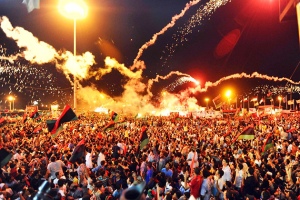 In a lot of ways, there is nothing surprising about Arab Spring 2.
In a lot of ways, there is nothing surprising about Arab Spring 2.
The movie begins in a manner largely reminiscent of 2011’s international hit, although it skips the Tunisian set-up. Egypt is introduced plagued by problems we thought were cured in the first flick: lengthy economic turmoil, shortages of food and other resources, and a military that is dubious at best about where its faith lies.
Most of the characters are as we left them at the end of the first Arab Spring: Mohamed Morsi is still the head of Egypt, a position he clutches tenuously, and in Syria (one of the few plots left unresolved in the first film), Bashar al-Assad is still in power. As portrayed by Ken Jennings in his feature debut, Assad takes on a sort of respectable fortitude – he is a man whom everyone hates, but whereas many of us would surrender for political asylum, he meets the mob’s jeers with bows and thanks.
And bombs, of course. This is big-budget filmmaking at its finest. Action sequences come one after the other, and the sheer magnitude of the huge protests is incredible – look at the work put into the crowd effects, where each face is detailed as though it were an individual. The height of these special effects is when Damascus goes up in flames. It is a masterwork of visual cinema, not likely to be toppled any time soon.
Unfortunately, the plot does not match the pop. The pervading sense of the film is, unfortunately, nonsense. These are people we just left with freedom, redeemed not by foreign aid but by their own wills. As a commentary on the American invasions in Afghanistan and Iraq (and arguably back to Vietnam and Korea), the original had a clear purpose, affirming liberty and sovereignty.
The sequel makes it feel like that was all for nothing. The Egypt story in particular is unfulfilling – the military seizes control of the state in the end, and though it is “chosen” by the people, you can tell the series is going to need to pull a reverse Marvel and give each country its own film in the future. Will people go out to watch what amounts to two hours of Libya or (dreadfully) Syria as a standalone film? This critic bets against it.
Arab Spring 2 can be aptly compared to one of those water bird toys, where it dips down, then up, then down, then up. There is no progress being made, and once the initial novelty of something new fades (along with the mesmerizing exhibit of something doing the work for itself), it just seems senseless, even stupid.
By time it concludes, the movie has come completely unglued. Things are blowing up, but there’s no longer any explanation, and it’s unclear which characters are responsible. As though trying to challenge the intellect of his audience (spoilers incoming, but they must be said!), director Steven Spielberg can’t resist slipping in the stupidest trope of our time: it is suggested during the Turkish revolution that ends the film that the cause of revolt may be a zombie virus.
Regardless of this (though akin to a zombie film), the visuals almost compensate for the sorrowful plot. Arab Spring 2 will never be remembered for its pulsating political purpose, nor for the inspiration towards liberty that Arab Spring achieved. However, when you see the bloodied pile of corpses in the streets of Alexandria, or the aforementioned Damascus ablaze, it still remains enough to, at the very least, make you hope that reality does not mimic art.